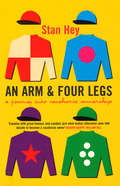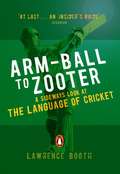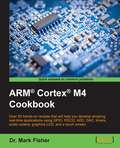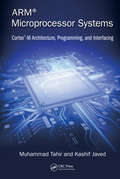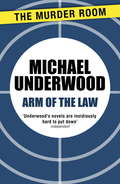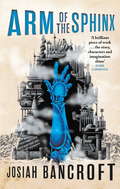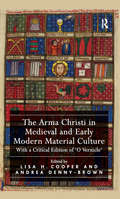- Table View
- List View
Arlott, Swanton and the Soul of English Cricket
by David Kynaston Stephen FayA fascinating account of how two BBC broadcasters battled for the soul of English cricket during a time of great social changeFor more than a quarter of a century after the Second World War, as the BBC tightened its grip on the national consciousness, two of the most famous English voices were commentators on games of cricket. John Arlott and E.W. ('Jim') Swanton transformed the broadcasting of the nation's summer game into a national institution. For any cricket follower in his fifties or older, just the mention of their names immediately evokes a flood of memories.Swanton was born into a middle-class family and privately educated; Arlott was the son of a working-class council employee, educated at state schools until he left at the age of sixteen. Because of their strong personalities and distinctive voices – Swanton's crisp and upper-class, Arlott's with its Hampshire burr – each had a loyal following in the post-war years, when England's class system had a slot for almost everyone. Within a few minutes of the start of a conversation, it would be possible to identify the speaker as an Arlott or a Swanton man.Arlott and Swanton never grew to like each other, but both typified the contrasting aspects of post-war Britain and the way both it and the game they loved was to change. As England moved from a class-based to a more egalitarian society, nothing stayed the same – including professional cricket. Wise, lively and filled with rich social and sporting history, Arlott, Swanton and the Soul of English Cricket shows how these two very different men battled to save the soul of the game as it entered a new era.
An Arm And Four Legs: A Journey into Racehorse Ownership
by Stan HeyEver wondered what it might be like to own a horse, not just back it with a pony on the nose - own it? Stan Hey did. A veteran of the windswept racecourses of National Hunt he finally decided to stop betting on other people's horses and join the inner circle. With the growth of partnerships and syndicates this has become increasingly possible so four horses, two trainers, and a few thousand pounds later Stan Hey had this story to tell. An Arm and Four Legs is his honest account of the pitfalls of racehorse ownership. Its fierce disappointments, escalating costs, skulduggery and deceit are set alongside the intense pleasure offered by an afternoon spent at the track, drinking, betting and chatting to your trainer while the rest of the world has its feet tucked under a desk.
ARM Assembly Language: Fundamentals and Techniques
by William HohlWritten by the director of ARM's worldwide academic program, this volume gives computer science professionals and students an edge, regardless of their preferred coding language. For those with some basic background in digital logic and high-level programming, the book examines code relevant to hardware and peripherals found on today's microco
ARM Assembly Language: Fundamentals and Techniques, Second Edition
by William Hohl Christopher HindsDelivering a solid introduction to assembly language and embedded systems, ARM Assembly Language: Fundamentals and Techniques, Second Edition continues to support the popular ARM7TDMI, but also addresses the latest architectures from ARM, including Cortex�-A, Cortex-R, and Cortex-M processors-all of which have slightly different instruction sets, p
ARM Assembly Language: Fundamentals and Techniques, Second Edition
by William Hohl Christopher HindsDelivering a solid introduction to assembly language and embedded systems, ARM Assembly Language: Fundamentals and Techniques, Second Edition continues to support the popular ARM7TDMI, but also addresses the latest architectures from ARM, including Cortex-A, Cortex-R, and Cortex-M processors-all of which have slightly different instruction sets, p
ARM Assembly Language with Hardware Experiments
by Ata Elahi Trevor ArjeskiThis book provides a hands-on approach to learning ARM assembly language with the use of a TI microcontroller. The book starts with an introduction to computer architecture and then discusses number systems and digital logic. The text covers ARM Assembly Language, ARM Cortex Architecture and its components, and Hardware Experiments using TILM3S1968. Written for those interested in learning embedded programming using an ARM Microcontroller.
Arm-ball to Zooter: A Sideways Look at the Language of Cricket
by Lawrence BoothWhat's the difference between short leg and deep midwicket? When would you be thinking about bowling a yorker? What's so great about the sound of leather on willow? Cricket’s vocabulary is a mixture of jargon and cliché, poetry and prose, misty-eyed romanticism and old-gits’ cynicism. Arm-ball to Zooter is a witty guide to the peculiarities of the game, its history and major figures; cricket-lovers might find their own pet hates confirmed; cricket newcomers might be amazed at what cricket-lovers have been up to all these years.
Arm Bends (Large Print)
by RnibThis page shows the arm, shoulder and two muscles seen from the front. The shoulder is in the top right. A locator dot and title are shown. These must always be at the top left of the page when the image is the right way up. The lower arm goes horizontally to the left centre of the page. Left and right of the vertical humerus bone are muscles. When the biceps (left of the humerus) contracts it pulls on the lower arm so that it moves upwards. The triceps (right of the humerus) relaxes.
Arm Bends (UEB Contracted)
by RnibThis page shows the arm, shoulder and two muscles seen from the front. The shoulder is in the top right. A locator dot and title are shown. These must always be at the top left of the page when the image is the right way up. The lower arm goes horizontally to the left centre of the page. Left and right of the vertical humerus bone are muscles. When the biceps (left of the humerus) contracts it pulls on the lower arm so that it moves upwards. The triceps (right of the humerus) relaxes.
Arm Bends (UEB Uncontracted)
by RnibThis page shows the arm, shoulder and two muscles seen from the front. The shoulder is in the top right. A locator dot and title are shown. These must always be at the top left of the page when the image is the right way up. The lower arm goes horizontally to the left centre of the page. Left and right of the vertical humerus bone are muscles. When the biceps (left of the humerus) contracts it pulls on the lower arm so that it moves upwards. The triceps (right of the humerus) relaxes.
Arm Candy (Mills And Boon Blaze Ser.)
by Jo LeighMarketing whiz Jessica Howell needs some "arm candy"–a deliciously sexy man by her side to keep her married playboy boss in line. Dan Crawford fits the bill–he's handsome, discreet and available. Definitely the perfect escort for the party circuit and media blitz surrounding Jessica's hot new cosmetics campaign.
Arm Candy
by Laura StruttSimple to make and fun to wear, friendship bracelets are the perfect homemade accessory to try your hand at. They make great gifts for friends – if you can bear to give them away!Have a go at using washi tape, cord, safety pins, loom bands, beads and even zips to make bracelets and bangles to wear stacked together or one at a time.
ARM® Cortex® M4 Cookbook
by Dr Mark FisherOver 50 hands-on recipes that will help you develop amazing real-time applications using GPIO, RS232, ADC, DAC, timers, audio codecs, graphics LCD, and a touch screenAbout This BookThis book focuses on programming embedded systems using a practical approachExamples show how to use bitmapped graphics and manipulate digital audio to produce amazing games and other multimedia applicationsThe recipes in this book are written using ARM's MDK Microcontroller Development Kit which is the most comprehensive and accessible development solutionWho This Book Is ForThis book is aimed at those with an interest in designing and programming embedded systems. These could include electrical engineers or computer programmers who want to get started with microcontroller applications using the ARM Cortex-M4 architecture in a short time frame. The book's recipes can also be used to support students learning embedded programming for the first time. Basic knowledge of programming using a high level language is essential but those familiar with other high level languages such as Python or Java should not have too much difficulty picking up the basics of embedded C programming.What You Will LearnUse ARM's uVision MDK to configure the microcontroller run time environment (RTE), create projects and compile download and run simple programs on an evaluation board.Use and extend device family packs to configure I/O peripherals.Develop multimedia applications using the touchscreen and audio codec beep generator.Configure the codec to stream digital audio and design digital filters to create amazing audio effects.Write multi-threaded programs using ARM's real time operating system (RTOS).Write critical sections of code in assembly language and integrate these with functions written in C.Fix problems using ARM's debugging tool to set breakpoints and examine variables.Port uVision projects to other open source development environments.In DetailEmbedded microcontrollers are at the core of many everyday electronic devices. Electronic automotive systems rely on these devices for engine management, anti-lock brakes, in car entertainment, automatic transmission, active suspension, satellite navigation, etc. The so-called internet of things drives the market for such technology, so much so that embedded cores now represent 90% of all processor's sold. The ARM Cortex-M4 is one of the most powerful microcontrollers on the market and includes a floating point unit (FPU) which enables it to address applications.The ARM Cortex-M4 Microcontroller Cookbook provides a practical introduction to programming an embedded microcontroller architecture. This book attempts to address this through a series of recipes that develop embedded applications targeting the ARM-Cortex M4 device family. The recipes in this book have all been tested using the Keil MCBSTM32F400 board. This board includes a small graphic LCD touchscreen (320x240 pixels) that can be used to create a variety of 2D gaming applications. These motivate a younger audience and are used throughout the book to illustrate particular hardware peripherals and software concepts.C language is used predominantly throughout but one chapter is devoted to recipes involving assembly language. Programs are mostly written using ARM's free microcontroller development kit (MDK) but for those looking for open source development environments the book also shows how to configure the ARM-GNU toolchain. Some of the recipes described in the book are the basis for laboratories and assignments undertaken by undergraduates.Style and approachThe ARM Cortex-M4 Cookbook is a practical guide full of hands-on recipes. It follows a step-by-step approach that allows you to find, utilize and learn ARM concepts quickly.
ARM Microprocessor Systems: Cortex-M Architecture, Programming, and Interfacing
by Muhammad Tahir Kashif JavedThis book presents the use of a microprocessor-based digital system in our daily life. Its bottom-up approach ensures that all the basic building blocks are covered before the development of a real-life system. The ultimate goal of the book is to equip students with all the fundamental building blocks as well as their integration, allowing them to implement the applications they have dreamed up with minimum effort.
ARM Microprocessor Systems: Cortex-M Architecture, Programming, and Interfacing
by Muhammad Tahir Kashif JavedThis book presents the use of a microprocessor-based digital system in our daily life. Its bottom-up approach ensures that all the basic building blocks are covered before the development of a real-life system. The ultimate goal of the book is to equip students with all the fundamental building blocks as well as their integration, allowing them to implement the applications they have dreamed up with minimum effort.
Arm of the Law (Simon Manton)
by Michael UnderwoodEat, drink, and be merry, for tomorrow we die ...It's the carnival motto for Trinidad's most colourful celebrations of the year. But, while thousands enjoy themselves in uninhibited eating, drinking and love-making, Detective-Superintendent Simon Manton is on the hunt for a dangerous killer. He has struck twice, and he will strike again. For one unlucky person the carnival motto is about to become a sinister reality.
Arm of the Sphinx: Book Two of the Books of Babel (The Books of Babel #2)
by Josiah Bancroft'Josiah Bancroft is a magician. His books are that rare alchemy: gracefully written, deliriously imaginative, action-packed, warm, witty and thought-provoking' Madeline Miller, author of Circe'Like its predecessor, it is a brilliant piece of work . . . these two books are genius. I just love them. The story, characters and imagination shine' Mark LawrenceForced by necessity into a life of piracy, Senlin and his eclectic crew struggle to survive aboard their stolen airship as the hunt for his lost wife continues. But the Tower of Babel is proving to be as difficult to re-enter as it was to escape.Hopeless and desolate, they turn to a legend of the tower, the mysterious Sphinx. But help from the sphinx doesn't come cheaply and, as Senlin knows, debts aren't always what they seem in the Tower of Babel.Praise for the series:'Brilliant' - Publishers Weekly'I loved it' - Django Wexler'An engrossing intoxicating delight' - Forbidden Planet 'An extraordinary debut that is well worthy of the hype. A beautifully written, highly engaging page-turning masterpiece' - Fantasy Book Review 'Thomas Senlin is the most unlikely yet likeable hero since a certain hobbit rushed out of Bag End leaving his second breakfast half-finished and entirely unwashed-up' - Fantasy Faction
Arm Straightens (Large Print)
by RnibThis page shows the arm, shoulder and two muscles seen from the front. A locator dot and title are shown. These must always be at the top left of the page when the image is the right way up. The shoulder is in the top right. The arm goes down to the bottom left of the page. Left and right of the vertical humerus bone are muscles. When the triceps (right of the humerus) contracts, it pulls on the lower arm so that it moves downwards. The biceps (left of the humerus) relaxes.
Arm Straightens (UEB Contracted)
by RnibThis page shows the arm, shoulder and two muscles seen from the front. A locator dot and title are shown. These must always be at the top left of the page when the image is the right way up. The shoulder is in the top right. The arm goes down to the bottom left of the page. Left and right of the vertical humerus bone are muscles. When the triceps (right of the humerus) contracts, it pulls on the lower arm so that it moves downwards. The biceps (left of the humerus) relaxes.
Arm Straightens (UEB Uncontracted)
by RnibThis page shows the arm, shoulder and two muscles seen from the front. A locator dot and title are shown. These must always be at the top left of the page when the image is the right way up. The shoulder is in the top right. The arm goes down to the bottom left of the page. Left and right of the vertical humerus bone are muscles. When the triceps (right of the humerus) contracts, it pulls on the lower arm so that it moves downwards. The biceps (left of the humerus) relaxes.
ARM System Developer's Guide: Designing and Optimizing System Software (ISSN)
by Chris Wright Andrew Sloss Dominic SymesOver the last ten years, the ARM architecture has become one of the most pervasive architectures in the world, with more than 2 billion ARM-based processors embedded in products ranging from cell phones to automotive braking systems. A world-wide community of ARM developers in semiconductor and product design companies includes software developers, system designers and hardware engineers. To date no book has directly addressed their need to develop the system and software for an ARM-based system. This text fills that gap. This book provides a comprehensive description of the operation of the ARM core from a developer’s perspective with a clear emphasis on software. It demonstrates not only how to write efficient ARM software in C and assembly but also how to optimize code. Example code throughout the book can be integrated into commercial products or used as templates to enable quick creation of productive software. The book covers both the ARM and Thumb instruction sets, covers Intel's XScale Processors, outlines distinctions among the versions of the ARM architecture, demonstrates how to implement DSP algorithms, explains exception and interrupt handling, describes the cache technologies that surround the ARM cores as well as the most efficient memory management techniques. A final chapter looks forward to the future of the ARM architecture considering ARMv6, the latest change to the instruction set, which has been designed to improve the DSP and media processing capabilities of the architecture.* No other book describes the ARM core from a system and software perspective. * Author team combines extensive ARM software engineering experience with an in-depth knowledge of ARM developer needs. * Practical, executable code is fully explained in the book and available on the publisher's Website. * Includes a simple embedded operating system.
Aršāma and his World: Volume II: Bullae and Seals (Oxford Studies in Ancient Documents)
During the Second World War the Bodleian Library in Oxford acquired a set of Aramaic letters, eight sealings, and the two leather bags in which the sealed letters were once stored. The letters concern the affairs of Aršāma, satrap of Egypt in the later fifth century. Taken with other material associated with him (mostly in Aramaic, Demotic Egyptian, and Akkadian), they illuminate the Achaemenid world of which Aršāma was a privileged member and evoke a wide range of social, economic, cultural, organizational, and political perspectives, from multi-lingual communication, storage and disbursement of resources, and satrapal remuneration, to cross-regional ethnic movement, long-distance travel, religious practice, and iconographic projection of ideological messages. Particular highlights include a travel authorization (the only example of something implicit in numerous Persepolis documents), texts about the religious life of the Judaean garrison at Elephantine, Aršāma's magnificent seal (a masterpiece of Achaemenid glyptic, inherited from a son of Darius I), and echoes of temporary disturbances to Persian management of Egypt. But what is also impressive is the underlying sense of systematic coherence founded on and expressed in the use of formal, even formalized, written communication as a means of control. The Aršāma dossier is not alone in evoking that sense, but its size, variety, and focus upon a single individual give it a unique quality. Though this material has not been hidden from view, it has been insufficiently explored: it is the purpose of the three volumes of Aršāma and his World: The Bodleian Letters in Context to provide the fullest presentation and historical contextualization of this extraordinary cache yet attempted. Volume I presents and translates the letters alongside a detailed line-by-line commentary, while Volume II reconstructs the two seals that made the clay bullae that sealed the letters, with special attention to Aršāma's magnificent heirloom seal. Volume III comprises a series of thematic essays which further explore the administrative, economic, military, ideological, religious, and artistic environment to which Aršāma and the letters belonged.
Aršāma and his World: Volume III: Aršāma's World (Oxford Studies in Ancient Documents)
During the Second World War the Bodleian Library in Oxford acquired a set of Aramaic letters, eight sealings, and the two leather bags in which the sealed letters were once stored. The letters concern the affairs of Aršāma, satrap of Egypt in the later fifth century. Taken with other material associated with him (mostly in Aramaic, Demotic Egyptian, and Akkadian), they illuminate the Achaemenid world of which Aršāma was a privileged member and evoke a wide range of social, economic, cultural, organizational, and political perspectives, from multi-lingual communication, storage and disbursement of resources, and satrapal remuneration, to cross-regional ethnic movement, long-distance travel, religious practice, and iconographic projection of ideological messages. Particular highlights include a travel authorization (the only example of something implicit in numerous Persepolis documents), texts about the religious life of the Judaean garrison at Elephantine, Aršāma's magnificent seal (a masterpiece of Achaemenid glyptic, inherited from a son of Darius I), and echoes of temporary disturbances to Persian management of Egypt. But what is also impressive is the underlying sense of systematic coherence founded on and expressed in the use of formal, even formalized, written communication as a means of control. The Aršāma dossier is not alone in evoking that sense, but its size, variety, and focus upon a single individual give it a unique quality. Though this material has not been hidden from view, it has been insufficiently explored: it is the purpose of the three volumes of Aršāma and his World: The Bodleian Letters in Context to provide the fullest presentation and historical contextualization of this extraordinary cache yet attempted. Volume I presents and translates the letters alongside a detailed line-by-line commentary, while Volume II reconstructs the two seals that made the clay bullae that sealed the letters, with special attention to Aršāma's magnificent heirloom seal. Volume III comprises a series of thematic essays which further explore the administrative, economic, military, ideological, religious, and artistic environment to which Aršāma and the letters belonged.
Aršāma and his World: Volume I: The Bodleian Letters (Oxford Studies in Ancient Documents)
During the Second World War the Bodleian Library in Oxford acquired a set of Aramaic letters, eight sealings, and the two leather bags in which the sealed letters were once stored. The letters concern the affairs of Aršāma, satrap of Egypt in the later fifth century. Taken with other material associated with him (mostly in Aramaic, Demotic Egyptian, and Akkadian), they illuminate the Achaemenid world of which Aršāma was a privileged member and evoke a wide range of social, economic, cultural, organizational, and political perspectives, from multi-lingual communication, storage and disbursement of resources, and satrapal remuneration, to cross-regional ethnic movement, long-distance travel, religious practice, and iconographic projection of ideological messages. Particular highlights include a travel authorization (the only example of something implicit in numerous Persepolis documents), texts about the religious life of the Judaean garrison at Elephantine, Aršāma's magnificent seal (a masterpiece of Achaemenid glyptic, inherited from a son of Darius I), and echoes of temporary disturbances to Persian management of Egypt. But what is also impressive is the underlying sense of systematic coherence founded on and expressed in the use of formal, even formalized, written communication as a means of control. The Aršāma dossier is not alone in evoking that sense, but its size, variety, and focus upon a single individual give it a unique quality. Though this material has not been hidden from view, it has been insufficiently explored: it is the purpose of the three volumes of Aršāma and his World: The Bodleian Letters in Context to provide the fullest presentation and historical contextualization of this extraordinary cache yet attempted. Volume I presents and translates the letters alongside a detailed line-by-line commentary, while Volume II reconstructs the two seals that made the clay bullae that sealed the letters, with special attention to Aršāma's magnificent heirloom seal. Volume III comprises a series of thematic essays which further explore the administrative, economic, military, ideological, religious, and artistic environment to which Aršāma and the letters belonged.
The Arma Christi in Medieval and Early Modern Material Culture: With a Critical Edition of 'O Vernicle'
by Lisa H. Cooper Andrea Denny-BrownThe Arma Christi, the cluster of objects associated with Christ’s Passion, was one of the most familiar iconographic devices of European medieval and early modern culture. From the weapons used to torment and sacrifice the body of Christ sprang a reliquary tradition that produced active and contemplative devotional practices, complex literary narratives, intense lyric poems, striking visual images, and innovative architectural ornament. This collection displays the fascinating range of intellectual possibilities generated by representations of these medieval ’objects,’ and through the interdisciplinary collaboration of its contributors produces a fresh view of the multiple intersections of the spiritual and the material in the Middle Ages and Renaissance. It also includes a new and authoritative critical edition of the Middle English Arma Christi poem known as ’O Vernicle’ that takes account of all twenty surviving manuscripts. The book opens with a substantial introduction that surveys previous scholarship and situates the Arma in their historical and aesthetic contexts. The ten essays that follow explore representative examples of the instruments of the Passion across a broad swath of history, from some of their earliest formulations in late antiquity to their reformulations in early modern Europe. Together, they offer the first large-scale attempt to understand the arma Christi as a unique cultural phenomenon of its own, one that resonated across centuries in multiple languages, genres, and media. The collection directs particular attention to this array of implements as an example of the potency afforded material objects in medieval and early modern culture, from the glittering nails of the Old English poem Elene to the coins of the Middle English poem ’Sir Penny,’ from garments and dice on Irish tomb sculptures to lanterns and ladders in Hieronymus Bosch’s panel painting of St. Christopher, and from the altar of the Sistine Chapel to the printed prayer books of the Reformation.

